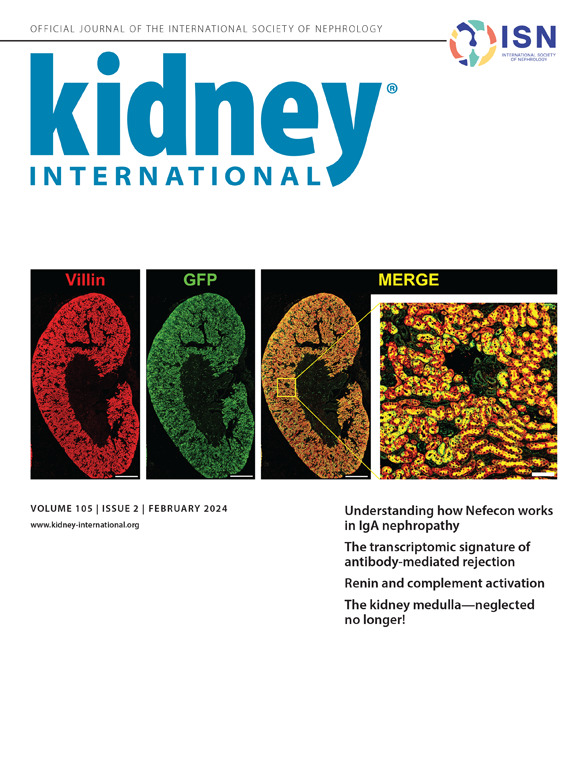Patient anti-PLA2R1 autoantibodies cause membranous nephropathy in human PLA2R1 transgenic mice.
IF 12.6
1区 医学
Q1 UROLOGY & NEPHROLOGY
引用次数: 0
Abstract
INTRODUCTION The discovery of anti-phospholipase A2 receptor 1 (PLA2R1) autoantibodies in patients with membranous nephropathy (MN) has led to a paradigm change in diagnosis, monitoring, risk prediction, and therapy of this autoimmune disease. However, there is only limited data on the pathogenicity of these autoantibodies. METHODS We purified the IgG from sera of patients with PLA2R1-associated MN and injected it into Rag2-deficient mice (mice lacking functional adaptive immunity) expressing human PLA2R1 in their podocytes. The IgG-depleted serum from the same patients and IgG purified from healthy individuals served as controls. RESULTS Two weeks after transfer, mice receiving anti-PLA2R1 IgG (largely IgG4), but not IgG-depleted serum or control IgG, developed proteinuria and showed granular deposition of human IgG and complement components of both the classical and alternative pathways in glomeruli by immunofluorescence and podocyte foot process effacement and subepithelial electron dense deposits in electron microscopy. There was no mouse IgG deposited. The IgG eluted from glomeruli of anti-PLA2R1 IgG-injected mice exclusively recognized PLA2R1. CONCLUSIONS Our findings provide evidence for a direct pathogenic role of anti-PLA2R1 autoantibodies, supporting the development of treatments aiming at the reduction of anti-PLA2R1 autoantibody levels.患者抗PLA2R1自身抗体引起人PLA2R1转基因小鼠的膜性肾病。
膜性肾病(MN)患者中抗磷脂酶A2受体1 (PLA2R1)自身抗体的发现导致了这种自身免疫性疾病的诊断、监测、风险预测和治疗的范式改变。然而,只有有限的数据对这些自身抗体的致病性。方法从PLA2R1相关MN患者血清中纯化IgG,并将其注射到足细胞中表达人PLA2R1的rag2缺陷小鼠(缺乏功能性适应性免疫的小鼠)中。将同一患者的IgG缺失血清和健康人的IgG纯化血清作为对照。结果在移植2周后,小鼠接受抗pla2r1 IgG(主要是IgG4),而不是IgG-贫血清或对照IgG,发生蛋白尿,并在免疫荧光和足细胞足突消退以及电镜下上皮下电子致密沉积的结果显示肾小球中有人类IgG和经典途径和替代途径补体成分的颗粒沉积。未见小鼠IgG沉积。从抗PLA2R1注射的小鼠肾小球中洗脱的IgG只识别PLA2R1。结论本研究结果为抗pla2r1自身抗体的直接致病作用提供了证据,支持了旨在降低抗pla2r1自身抗体水平的治疗方法的开发。
本文章由计算机程序翻译,如有差异,请以英文原文为准。
求助全文
约1分钟内获得全文
求助全文
来源期刊

Kidney international
医学-泌尿学与肾脏学
CiteScore
23.30
自引率
3.10%
发文量
490
审稿时长
3-6 weeks
期刊介绍:
Kidney International (KI), the official journal of the International Society of Nephrology, is led by Dr. Pierre Ronco (Paris, France) and stands as one of nephrology's most cited and esteemed publications worldwide.
KI provides exceptional benefits for both readers and authors, featuring highly cited original articles, focused reviews, cutting-edge imaging techniques, and lively discussions on controversial topics.
The journal is dedicated to kidney research, serving researchers, clinical investigators, and practicing nephrologists.
 求助内容:
求助内容: 应助结果提醒方式:
应助结果提醒方式:


